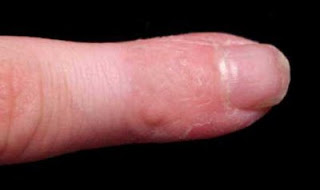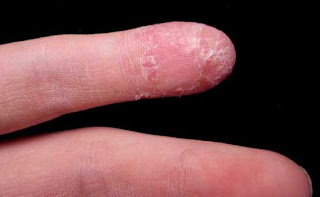
In October 2007, we presented the case of an eight year old girl with chronic paronychial inflammation located on the left index finger (
Paronychia in a Child). She had no other dermatoses. The patient is adopted so we have no family history. We assumed this was some kind of localized psoriasis or acrodermatitis continua. Clobetasol ointment was prescribed which she has used since.
(Photo above from 10/2007)
The patient was seen in follow-up recently. The paronycial inflammation had subsided but the finger tip was still abnormal, especially on the palmar surface and there is now hypopigmentation and atrophy distal to the area of inflammation. This latter is likely secondary to the clobetasol. Her topical therapy was switched to calcipotriene cream (the ointment is no longer available in the US.)
Photos:

 Questions:
Questions:1) What do you think the diagnosis is?
2) Side-effects on the fingers from super-potent topical corticosteroids are rarely reported. One suspects that they are not that unusual. When does the treatment get worse than the disease? (I should have been more diligent in follow-up)
3) Who thinks that these preparations can cause bone changes?
Your comments will be appreciated.References:1. Deffer TA, Goette DK.. Distal phalangeal atrophy secondary to topical steroid therapy. Arch Dermatol. 1987 May;123(5):571-2.
2. Tosti A, Fanti PA, Morelli R, Bardazzi F. Psoriasiform acral dermatitis. Report of three cases. Acta Derm Venereol. 1992;72(3):206-7.
Department of Dermatology, University of Bologna, Italy.
The authors report 3 patients affected by psoriasiform acral dermatitis, a distinctive clinical entity characterized by a chronic dermatitis of the terminal phalanges, associated with marked shortening of the nail beds of the affected fingers. The skin biopsy showed in all cases the pathological features of a subacute spongiotic dermatitis. X-ray examination of affected fingers showed no bone or soft tissue changes. Differential diagnosis of psoriasiform acral dermatitis included psoriasis, atopic or contact dermatitis and corticosteroid-induced distal phalangeal atrophy.
3. Brill TJ, Elshorst-Schmidt T, Valesky EM, Kaufmann R, Thaçi D. Successful treatment of acrodermatitis continua of Hallopeau with sequential combination of calcipotriol and tacrolimus ointments. Dermatology. 2005;211(4):351-5.
Department of Dermatology, J.W. Goethe University, Frankfurt, Germany.
Acrodermatitis continua of Hallopeau (ACH) is a rare type of pustular psoriasis affecting the digits. We report on a 43-year-old female patient who had been suffering from ACH for more than 20 years. Despite the fact that the disease was localized on one finger during the whole period, several topical and systemic treatments resulted in only temporary or partial improvement of the lesion. Although the monotherapies with calcipotriol and tacrolimus ointments gave no satisfying results in the long-term management of the disease, the combination of both agents led to a continuous improvement of the patient's skin condition. Copyright 2005 S. Karger AG, Basel.





